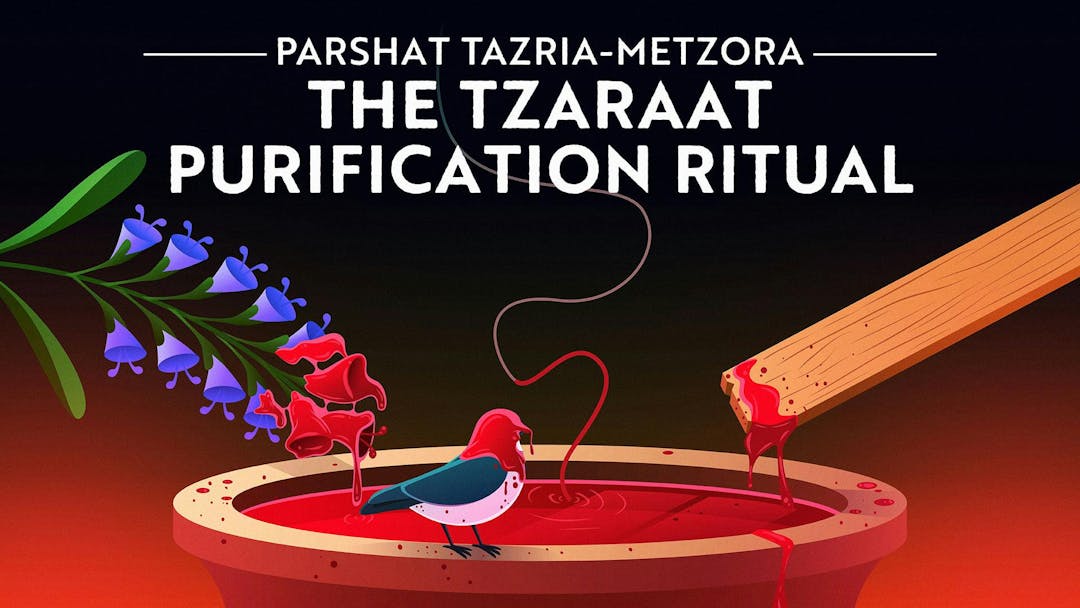Metzora is the weekly Torah portion read on May 3, 2025
Parshat Metzora: Dvar Torah, Summary, Meaning & Torah Portion
Metzora Torah Portion: Leviticus 14:1–15:33
In Parshat Metzora, we continue learning the laws of tzara'at, including how to identify and treat the condition.
Featured Metzora Video
The Meaning Behind The Mikvah Rituals
Why do we go to the mikvah? Why does dunking in the mikvah’s waters leave us feeling “pure”? Join us as we take a deeper look at the meaning of this ritual bath and breathe new life into this mysterious custom.
Parshat Metzora Torah Portion
Metzora Dvar Torah & Meaning
Parshat Metzora Summary & Commentary
Metzora Torah Portion: Leviticus 14:1–15:33
Parshat Metzora is commonly read in the same week as Parshat Tazria, and for good reason: together, these two parshiyot tell the full story of tzara'at, a mysterious ailment that renders people spiritually impure (tamei) and requires treatment. The verses in Parshat Tazria that describe the symptoms of tzara'at are extremely detailed and graphic and may even make our eyes glaze over, but by the time we get to Parshat Metzora and we read about the purification process for the metzora (the person afflicted with tzara'at), things start to get a little bit more interesting. What does the purification process look like? What needs to happen in order for the metzora to become pure (tahor) once again, to heal himself of his affliction?
It's a bizarre ritual: a priest (who is in charge of diagnosing the ailment and overseeing the ceremony) collects a series of seemingly-random objects: two birds, a plank made of cedar wood, a scarlet-colored thread, an earthenware vessel, a bundle of hyssop (a kind of herb), and living waters (generally understood to be water from a running stream). One of the birds is killed, and its blood is made to drip into a pool of the water into the vessel. Then the priest takes the live bird — along with the wood, the thread, and the hyssop — and he dips them into the blood of the dead bird and sprinkles them onto the metzora. The live bird is then sent away. At the end of this purification procedure, the metzora is allowed to come back into the camp, but he still has to wait outside of his home for seven days.
Is there any meaning, today, to be gleaned from the odd details of this ritual? The answer is yes, and here's where it begins: Rabbi Fohrman notices that the details of the purification process, strange though they may be, may also sound familiar to us. They harken back to another story in the Torah, an earlier story, one that also involved many of these elements: a bundle of hyssop, blood, wood, blood going into water, a seven-day period during which something had to stay outside of the house, this theme of two beings, one of which dies and one which is sent away. What is that story? It's a formative story in the history of the children of Israel, the story that details when the people became a nation. In the parallels between these two stories lies the exceedingly deep meaning of this strange purification process for the metzora — and indeed, a suggestion about the meaning of tzara'at itself. Rabbi Fohrman presents the full theory with all of his evidence in his two-part series on Tazria and Metzora, "The Tzaraat Purification Ritual: What Does It Mean?"
The fascinating topic of the metzora is not all that we find in this parsha. After concluding the topic, we read about other kinds of tumah, ritual impurity: like that of a man or woman who experiences a discharge, be it natural or unnatural, seminal or not. Contained in this discussion are the laws of the niddah, the menstruating woman, who is prohibited from marital relations and must observe a period of "clean days" after her period stops before she can immerse in a mikvah ("ritual bath"), which is needed for her to become tahor ("ritually pure"). But how can a bath suddenly make you pure? We ask the same question here: Why Does The Mikvah Make Me Pure?
Check out the full text of the Parsha here.
Interested in learning more about the upcoming Parshiot? Check out Aleph Beta’s Parsha pages on Acharei Mot, Kedoshim and Emor!




